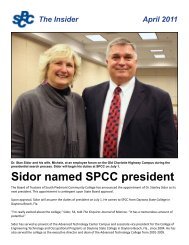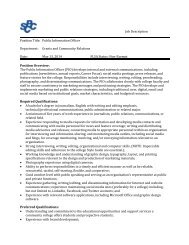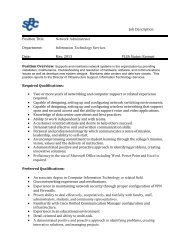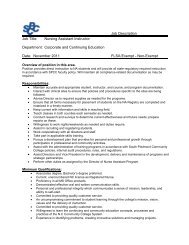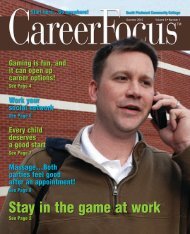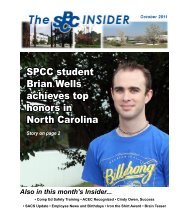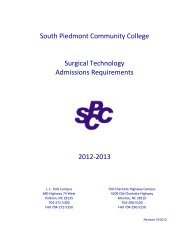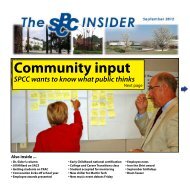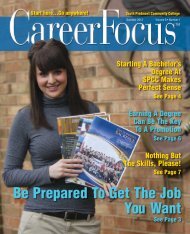June 2012 Insider - South Piedmont Community College
June 2012 Insider - South Piedmont Community College
June 2012 Insider - South Piedmont Community College
Create successful ePaper yourself
Turn your PDF publications into a flip-book with our unique Google optimized e-Paper software.
The <strong>Insider</strong> <strong>June</strong> <strong>2012</strong>Few problems with SACS reportHello Everyone,It is hard to believe that another month has passed and we are well intothe summer semester. By now you may have heard that our SACS offsitecompliance report results are back and were very good.Stan Sidor______________SPCC PresidentWe had eight minor non-compliances, which we hope to quickly addressthis summer. Most of these were procedural or explanatory in nature(for example, the team was not able to open the electronic credentialfile; thus, a noncompliance in faculty credentialing for a couple of seniormembers of the faculty. In our focused report, we will provide additionalexplanation and documentation to address this and the other non-compliances. In comparison, one of our sister colleges had24 similar non-compliances, which it will work on this summer.The very good news in this report is that none of the non-compliances were systemic or pointed to systemic failures. For ournext step, we hope to partner with another North Carolina community college to conduct a mock on-site audit in late July orearly August in preparation for the visiting team visit in late October.Thank you for all of your hard work in preparing the report and working within and improving our systems in service to ourcommunity and students.In the next few weeks, we will form the planning council committee and make preliminary sub-committee assignments. Thiscouncil will provide everyone more input into the decision and resource allocation process at the college. I will send everyonethe description of the new process and team assignments via e-mail.Also this summer, we are conducting a limited pilot of e-text and participating in a larger statewide initiative to evaluate thisnew instructional support mechanism. Later this summer, I will report on some additional initiatives in process and provideyou some interesting information related to the changing landscape of higher education.Take care, enjoy your families and friends, and relax in preparation for another very busy academic year.
The <strong>Insider</strong> <strong>June</strong> <strong>2012</strong>SPCC adds EMS Bridge degree<strong>South</strong> <strong>Piedmont</strong> <strong>Community</strong> <strong>College</strong> is adding an Emergency Medical Science Bridgeprogram this fall that will allow professional emergency medical technicians andparamedics to get credit for their real-world experience in earning an associate degree. Theassociate degree will then allow them to continue their education or perhaps seek a betterpayingjob.“Both Union and Anson (counties) are looking for EMS professionals with degrees,”said Stuart Wasilowski, SPCC’s vice president of the School of Applied Science andTechnology.The program allows the college to count specific work experience toward classroom hours. Wasilowski Bradley“In effect, they’re getting credit for the knowledge base and competencies that they alreadyhave,” Wasilowski said. “What typically happens, people come here to get EMT, they stay on and get EMT-Paramedic. That’s1,300 hours. These folks were at a dead end in terms of (further) education. This opens a pathway back to the college to gettheir degree, and go on for a bachelor’s degree.”To qualify for the program, a student would have to provide proof of certification in Basic Trauma Life Support (BTLS orPHTLS), Advanced Trauma Life Support (ACLS) and Pediatric Advanced Life Support (PALS); proof of current HealthProvider CPR certification; and written proof of 3,000 paid hours as a paramedic.“In order to make sure we were awarding credit appropriately, we did a lot of research,” said Alice Bradley, associate dean ofAllied Health.The curriculum is set up for the program to be completed in two semesters, but Bradley said some people might be ableto complete it in one. The credit earned for certifications and real-world experience will account for many of a student’sprerequisites, she said, but “they will also have general studies. Nine times out of 10, these folks aren’t going to (already) havethe general studies,” she said.Students who successfully complete the program will earn an associate in applied science degree in Emergency Medical Science.For information about the program, contact Bradley at 704-290-5832 or abradley@spcc.edu or EMS Coordinator RobbySmith at 704-290-5817 or rsmith@spcc.edu.
The <strong>Insider</strong> <strong>June</strong> <strong>2012</strong>SPCC selected for humanities project<strong>South</strong> <strong>Piedmont</strong> <strong>Community</strong> <strong>College</strong> has been selected to participate in the <strong>Community</strong> <strong>College</strong> Humanities Association’s“Advancing Humanities: A National Endowment for the Humanities Bridging Cultures Project.”SPCC was one of 18 community colleges, and the only one from North Carolina, selected from among 70 applications from30 states.The purpose of the project is to advance cultural and civic understanding in introductory humanities courses. The 18 collegeswill receive day-to-day guidance from humanities scholars and experienced community college humanities mentors as theystrengthen their curriculums and engage in faculty development and scholarship in one of five disciplines: literature, history,philosophy, religion or civic engagement.SPCC will participate in literature. Its three-person team will consist of Dean of Arts and Sciences Valerie Jones and EnglishInstructors Sherri Breitigan and Tammy Frailly.The project will pay travel expenses for two of the team members to attend the National Bridging Cultures Conferenceon Sept. 27-29 in Washington, D.C., and for one to attend the same conference in December 2013 at a location yet to bedetermined. The project will provide stipends for Breitigan and Frailly to pursue project tasks and independent scholarship tostrengthen preparation and enrich their teaching.At the conference in September, SPCC’s team will work with mentors and scholars there to begin developing a plan to advancecultural understanding toward building a community and begin developing an action plan for implementation during theproject’s 18-month period.The impetus for SPCC to apply for the program was a course that will be new at SPCC next spring. English 262 (WorldLiterature II) will introduce selected works from the Pacific, Asia, Africa, Europe and the Americas from the 18 th century to thepresent. Many of these are works that SPCC instructors have not taught before and the college wanted to ensure that facultycould help its students – many of whom have had little exposure to diverse religions, socioeconomic classes and ethnicities –gain an appreciation for the importance of intercultural understanding. This will also benefit many of these students who latertransfer to four-year universities and move farther out of their comfort zones.
The <strong>Insider</strong> <strong>June</strong> <strong>2012</strong>Minority male mentoring program changing<strong>South</strong> <strong>Piedmont</strong> <strong>Community</strong> <strong>College</strong>’s minority male mentoring program is undergoing some changes – and it will no longerbe just for minorities or males.Even though the revitalized program is just getting off the ground, the concept is already drawing interest from othercommunity colleges. Program director Serena Johnson and program coordinator Jonathan Klish presented SPCC’s plan to 43community colleges last month in Durham and have already received calls from other schools requesting assistance with theirprograms.Previously known as IMPACT, the program will transform into a multi-faceted student support initiative. Under the formermodel, IMPACT was a club that recruited students and most services were delivered during weekly meetings. Club advisorsfound that the challenges many students face – two campuses 26 miles apart, lack of public transportation in Union and Ansoncounties, competing adult demands and many classes being taken online – all inhibited participation.Club advisors hope to increase student participation by rebranding the program. In its new incarnation, the multi-cultural clubwill be race and gender inclusive instead of just for minority males. With the help of mentors and staff, members will cultivatethe development of peer support systems. The primary emphasis will be on campus tours, leadership development, personalenrichment, and recreation and fun.With the help of faculty, an early alert system will be developed to prevent struggling students from falling so far behind thatthey cannot recover. Instructors will be on the lookout for excessive absences, poor in-class participation, missed assignments,low grades, and behavioral and disciplinary issues.The club will also employ something known as Active Outreach Advising – Case Management. The school will take theinitiative to reach out to students, especially at critical junctures throughout the semester. All minority male students will bescreened for potential intervention. Helping relationships will be built through ongoing contact and students will receive helpexploring services and programs that foster academic success.The transition to a multi-cultural club has already begun. The program will be fully implemented at the beginning of the fallsemester.
The <strong>Insider</strong> <strong>June</strong> <strong>2012</strong>Magazine lauds aerospace cluster<strong>South</strong>ern Business and Development magazine has named Monroe one of its Top 10 Successful Aviation and Aerospace Clusters inthe <strong>South</strong> for <strong>2012</strong>. This is the second recognition Monroe’s aerospace cluster has received by <strong>South</strong>ern Business and Developmentsince 2010 and adds to a long list of national and regional acknowledgements for its economic development efforts.Following Sept. 11th, 2001, Monroe began an effort to further modernize and diversify its economy. Monroe EconomicDevelopment worked with its small core group of aerospace suppliers in 2002 and has produced North Carolina’s largest geographicconcentration of aerospace companies. Since the initiative began, approximately 3,000 jobs have been created and nearly $600million invested by aerospace companies. These high‐paying, high‐technology precision manufacturers now represent 26 percent ofthe entire manufacturing labor force of Monroe.“It is such an honor to continue to receive recognition as a national leader in aerospace,” said Chris Platé, executive director ofMonroe Economic Development. “It demonstrates to everyone the level of effort and support the city has put toward theaerospace initiative.”<strong>South</strong> <strong>Piedmont</strong> <strong>Community</strong> <strong>College</strong> and the Union County Public Schools have proactively developed programs of study andfacilities to support the labor needs of the aerospace sector in Monroe. In 2010, <strong>South</strong> <strong>Piedmont</strong> created its Aerospace and AdvancedManufacturing Training Center. This facility offers state‐of‐the‐art equipment and process instruction tailored to and designed by thecompanies. These capabilities are only offered by a select few education institutions in the nation.“SPCC has worked hand in hand with existing aerospace and advanced manufacturing companies to develop creative, flexible,and responsive training programs for this high-skill, high‐wage sector,” SPCC President Stan Sidor said. “Our partnership withUnion County Public Schools helps fill the pipeline for the technically skilled and innovative employees these companies need. Weare excited to be a part of such a comprehensive community partnership focused on creating a highly skilled technology‐focusedworkforce for the new economy.”
The <strong>Insider</strong> <strong>June</strong> <strong>2012</strong>Seen around campusFaculty SenateThe Executive Board for the new Faculty Senatewas recently installed at a meeting at the JesseHelms Center. Pictured are, from left, front row,Vice President Lori Hupp, Parliamentarian ReneeFaulcon, Secretary-Treasurer Kim Bateman; backrow, Arts and Sciences Representative JasonClarke, President Claudius Oni, and AppliedScience and Technology Representative OscarGonzalez.Spring plant saleJason Miller, Horticulture instructor at BrownCreek Correctional Institution, displays some ofthe few remaining plants he had available forthe spring plant sale on the Old CharlotteHighway Campus. Miller’s students grow theplants to raise money for the program.
The <strong>Insider</strong> <strong>June</strong> <strong>2012</strong>Campus briefsMassage Therapy clinic hours extended for fund-raiser<strong>South</strong> <strong>Piedmont</strong> <strong>Community</strong> <strong>College</strong>’s Massage Therapy students will extend the hours of their clinics for two weeks in <strong>June</strong>and two weeks in July to raise funds for the students’ state board and licensing fees.The clinics, which will be on the Old Charlotte Highway Campus in Monroe, allow the students to put into practice what theyhave learned in the classroom.The extended hours will be from 3 p.m. to 7 p.m. <strong>June</strong> 18-21, <strong>June</strong> 25-28, July 9-12 and July 16-19. During those times,cost is $25 per hour. Customers may choose a one-, two- or three-hour massage, and choose from Swedish massage, hot stonemassage, sports massage, deep tissue massage, modulated table Thai massage, forearm dance, frozen shoulder and trigger pointtherapy, or some combination of the above. Customers may also choose their therapists.Massages during the extended hours will be by appointment only. Call Mary Berger at 704-290-5865 for more information orto make an appointment.University of Phoenix offers tuition reduction for SPCC employees, gradsTuition will be reduced 5 percent for <strong>South</strong> <strong>Piedmont</strong> <strong>Community</strong> <strong>College</strong> graduates and employees who seek bachelor’sdegrees or higher through the University of Phoenix.A new Alliance Memorandum of Understanding between the two institutions also allows SPCC graduates and employeeswho seek such a degree to have assessments of professional training that would not normally count as credit toward a degreeprogram. That training must have occurred at SPCC or an affiliated skill or training center.The tuition reduction and free prior learning assessment will be granted only to new University of Phoenix students.University of Phoenix is also offering 70 scholarships valued at $3,000 each for students who transfer from an accreditedcommunity college. Applicants must already be admitted and must be in the first three bachelor-level degree credits atUniversity of Phoenix at the time of the application deadline (<strong>June</strong> 26).For more information or an application, go online to www.phoenix.edu/CCTransferScholar.
The <strong>Insider</strong> <strong>June</strong> <strong>2012</strong>Employee newsJamie Turner has been a familiar face to patrons of the Horne Library on the L.L. Polk Campus forseveral years. After working there part time for four years, she recently became a full-time librarytechnician. Turner, who graduated from SPCC with a degree in Medical Office Administration in 2011,also volunteered at the library in 2005 while she was working on her GED. She later worked thereas part of work-study and stayed on afterward. A resident of Peachland, Turner’s husband and twochildren – a 10-year-old daughter and 3-year-old son – occupy most of her time away from work.Turner<strong>June</strong> birthdays<strong>June</strong> 3: Russell Carpenter, Tammy Frailly, Cari Thompson<strong>June</strong> 4: Alice Bradley, Robin Cook, Derek James, LaurenSellers<strong>June</strong> 5: Joe Cameron<strong>June</strong> 6: Karen Elizabeth Smith<strong>June</strong> 8: Bengie Mullis<strong>June</strong> 9: Kathy Aldridge<strong>June</strong> 13: Hollie Lackey<strong>June</strong> 15: Lori Starnes<strong>June</strong> 16: Rosemary Britt, Michele Sidor, Jason Thomas<strong>June</strong> 17: Jerry Caudle<strong>June</strong> 19: John Dabbs<strong>June</strong> 20: Jermaine Alston, Janet Otton<strong>June</strong> 22: Linda Ward<strong>June</strong> 24: Ginger McLain<strong>June</strong> 25: Dianne Honeycutt<strong>June</strong> 27: Tracey Griffith<strong>June</strong> 28: Debra Griffin<strong>June</strong> 29: Teresa Downer<strong>June</strong> 30: Mike Cafferty, John Ratliff
The <strong>Insider</strong> <strong>June</strong> <strong>2012</strong>Brain TeaserHere’s another one from Lew Powell’s “The Ultimate North Carolina Quiz Book.” If Stephen Foster had stuck with his originalversion of “Old Folks at Home,” what North Carolina river would have become a household word? Send answers to JimMuldrow at jmuldrow@spcc.edu. Be sure to put “Brain Teaser” in the subject line. All correct answers received by noon <strong>June</strong>11 will be placed in a drawing to determine the winner.Last month’s winnerAssistant Director of Financial Services Karen Grantham poses with theSPCC apron she won after her entry was selected at random from all thecorrect entries in last month’s contest. Last month’s question was “AnArab sheikh tells his two sons to race their camels to a distant city to seewho will inherit his fortune. The one whose camel is slower will win. Thebrothers, after wandering aimlessly for days, ask a wise man for advice.After hearing the advice they jump on the camels and race as fast as theycan to the city. What does the wise man say?” The correct answer is he toldthem to switch horses.




